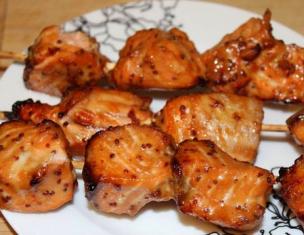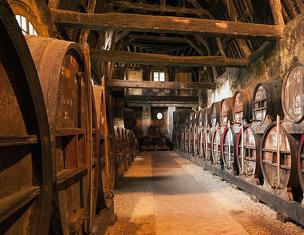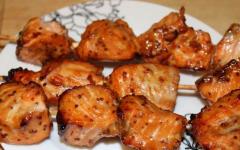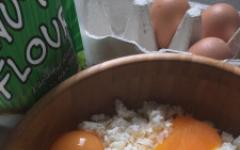Butter, obtained by whipping natural cream, has a high nutritional value and has a positive effect on the body. Its different types have different fat content. The natural product usually contains nothing but cow's cream. Sometimes salt and spices are added to it. A quality product may be yellowish or dark yellow, depending on the fat content of the cream.
WEIGHT LOSS STORIES OF STARS!
Irina Pegova shocked everyone with her weight loss recipe:“I lost 27 kg and continue to lose weight, I just brew it at night...” Read more >>
- healing of wounds and injuries;
- restoration of the mucous membranes of the esophagus;
- prevention of diseases of the digestive system;
- treatment of cholelithiasis;
- normalization of the production of sex hormones;
- improving the functioning of the central nervous system;
- stabilization of cholesterol levels in the blood;
- stimulation of the growth of new cells in the body;
- improving the condition of skin, hair, nails.
- diarrhea;
- colic;
- increased gas formation;
- heaviness in the stomach;
- nausea.
- obesity;
- diabetes;
- liver diseases.
Show all
Chemical composition and BZHU
The chemical composition of a natural creamy product contains a large number of microelements
The nutritional value of the product is quite high. BJU ratio:
The product contains a large amount of cholesterol - 215 mg, which is almost three times the norm. The composition contains 18 g of water.
The calorie content of a product largely depends on its variety. 100 g of Peasant Butter contains 665 kilocalories. The sandwich variety contains 567 kcal, and the tea variety - 545 kcal.
Real butter is produced only from natural cream and has a fat content of at least 82%. If the manufacturer indicates a lower amount of fat content, then the product contains additional food additives. This is already a spread, ersatz or margarine. Before purchasing oil, be sure to check its composition.
Product Application
The oil is used in cooking, medicine, and cosmetology. In medicine, the product is used as a nourishing, warming and softening component. It is used in the treatment of esophagus, diarrhea, bronchitis, viruses, and exhaustion of the body.
The most common use of oil is in cooking. The product is used to prepare various dishes. Creams, desserts, and sauces are made from it.
To avoid harm to health, oil should be eaten in limited quantities, otherwise it may cause intestinal upset. The product is allowed to be consumed by adults in the amount of 15-20 g per day, by children in the amount of 10 g per day. It is recommended to spread it on bread and eat it with cheese, sausage, fish, vegetables or caviar.

Benefits and harms
In addition to the unique taste and aroma, the product has a lot of useful properties, which are manifested in the following effects on the body:
For women, butter is necessary, as it helps prepare the body for pregnancy, saturate it with the required fats before the start of the cycle, and stabilize the condition during menopause. Regular consumption of 1 teaspoon per day will help a woman maintain youthful and beautiful skin, get rid of dryness and microcracks.
Men especially need the product during increased physical activity. After 40 years, it is important to eat 1 sandwich with butter for breakfast to prolong youth, increase potency, lower cholesterol levels, which will minimize the risk of stroke and heart attack.
Excessive consumption of oil can cause serious harm to the human body. If you overeat, it can cause:
The product has contraindications, including:
Oil with high fat content increases the load on the liver several times, which can provoke a deterioration in health in chronic hepatitis and other diseases.

For children
A growing body needs fats for proper growth and development. Regular consumption of butter helps saturate it with fatty acids, which are an essential source of vital energy.
Low birth weight babies need oil, as it stimulates the digestive system and improves appetite. The product helps relieve constipation. Fatty acids help in the formation of healthy nerve cells and provide the growing brain with the required nutrients.
The product should be added to the porridge in small quantities. It is recommended to consume it in the morning so as not to overload the digestive system in the evening. Children can stew vegetables with the addition of butter or use it when frying.
During pregnancy
Pregnant women will benefit from 25 g of oil per day. The product promotes the proper formation of the child’s musculoskeletal system, and the vitamins and minerals in its composition help the expectant mother maintain the beauty of her hair, nails and skin throughout the entire gestation period. Cholesterol, which is part of it, is involved in the formation of cells.
During lactation, the product is allowed to be consumed only if the baby is not allergic to cow protein. If it is absent, then you can include butter in the menu, as it will enrich the milk with essential fatty acids. During lactation it is recommended to add it to soups, cereals, and milk.
Ghee and ghee
Natural butter consists of proteins, fats, carbohydrates and water. Rendered product is pure fat that can be added when frying. It goes well with spices such as ginger, turmeric, cumin, and black pepper. The Indian "brother" of ghee is ghee.
Ghee is used for proper and healthy nutrition. It is distinguished from the Russian product by its preparation technology and chemical composition. The taste qualities of ghee and ghee are also dissimilar. Its taste is nutty, sweetish caramel. The composition contains not only fat, but also vitamins A, B3, D and E, calcium, sodium, phosphorus, magnesium, potassium, iron and some other minerals.
The number of calories in the two oil products is almost the same and amounts to 850-900 kcal per 100 grams. It is permissible to eat no more than a tablespoon per day. Otherwise, you can seriously harm the body.
At home, you can prepare medicines based on ghee and ghee. Nourishing face masks are very popular. Preparing them is quite simple; to do this, mix 1 teaspoon of oil with 1 egg and apply on your face for 15 minutes, then rinse with warm water.
To improve digestion, ghee should be taken after meals. It will help better absorb vitamins and minerals from other foods. It is recommended to add it to vegetables and cereals.
And a little about secrets...
The story of one of our readers, Inga Eremina:
I was especially depressed by my weight; at 41, I weighed as much as 3 sumo wrestlers combined, namely 92 kg. How to completely lose excess weight? How to cope with hormonal changes and obesity? But nothing disfigures or makes a person look younger than his figure.
But what can you do to lose weight? Laser liposuction surgery? I found out - no less than 5 thousand dollars. Hardware procedures - LPG massage, cavitation, RF lifting, myostimulation? A little more affordable - the course costs from 80 thousand rubles with a nutritionist consultant. You can, of course, try to run on a treadmill until you go crazy.
And when will you find time for all this? And it's still very expensive. Especially now. That's why I chose a different method for myself...
The diet of a healthy person includes fats, proteins, carbohydrates, and vitamins. Butter is a necessary and valuable product for the life of the body, and it is very tasty. The modern dairy products market provides a huge selection of these products. It is important to be able to distinguish true oil from a low-quality product. Butter, the calorie content of which is below 82.5%, does not belong to the quality category. The same applies if it is made with the addition of substitutes.
Calorie content, chemical composition and fat content

From this classification it becomes clear that the naturalness of butter depends on its fat content.
The fattest butter is ghee. Manufacturers achieved a high rate (98%) by removing sugar, water and proteins from natural butter.
How to choose a quality product
When producing butter, it is permissible to add some ingredients that do not affect the number of calories, but can enrich the taste. These are products such as berry and fruit juices, cocoa, honey, vanillin, sugar.
What you need to know about the quality of oil so as not to buy a fake in a beautiful wrapper:
- Natural oil dissolves evenly in hot water;
- Margarine will break into pieces in such an environment;
- A real product from the freezer will take a long time to defrost;
- The spread can easily be spread on bread in just five minutes.
How much can you use?
Butter has become a part of our lives. Morning breakfast is not complete without a sandwich with butter, cheese, sausage and a cup of coffee. We also use this “menu” when traveling. Baking is generally unimaginable without this product, and it is also present in recipes for various dishes and dressings. Is it possible to use it a lot and often, or not?
It is not recommended to consume a high-calorie product in large quantities. Small portions are healthy and necessary. They give energy, strength, and promote cell renewal. Various studies have shown that vitamin A contained in butter is not only useful, it is simply necessary for people with diseases of the stomach and duodenum (gastritis, ulcers), and promotes faster healing of wounds. By the way, if a child is limited in oil consumption, he will not receive the beneficial substances contained in the product. This can cause mental retardation in the baby.
But a lot doesn’t mean it’s useful. In everything it is necessary to observe moderation and in the use of oil as well. A large amount of cholesterol in it can lead to excess weight gain, and ultimately obesity. Therefore, it is necessary to control its intake - the daily norm is no more than twenty grams. In this case, your cholesterol level will remain the same and you will not be overweight.
In our diet, butter is one of the main products. It is used in the preparation of many dishes and is consumed for breakfast, lunch and dinner. It is considered the most valuable and good because it has high nutritional value, and also has a pleasant smell and taste. Find out how many calories there are and calculate your daily requirement.
Calorie content of oil
The calorie content of butter, if it is made according to standards, should be 748 kcal per 100 g. Compared to other products, this is quite a high figure, for example, it is more than the calorie content of 100 g of the fattest chips. The most high-calorie fruit, banana, has about 8 times less calories than butter.
A tablespoon can hold about 30 g. One gram of oil contains 7.48 kcal. From the calculation you can get 224.4 kcal, which are contained in a tablespoon.
With butter
Many people eat such a sandwich for breakfast, but do not even suspect that the amount of fat greatly exceeds the calorie content. Bread and butter may fill you up, but it will add extra calories.
How do you know with butter? A sandwich made of black bread with butter has a calorie content of 170 kcal. With white bread, the sandwich will have 20 kcal less. But it is healthier to eat black bread. These figures are calculated per 100 g of products. And your sandwich is probably 2-3 times larger in weight, which means you eat a lot of calories as a snack.

Where is it used?
There are many types of oils, but ghee is made from butter. This happens as follows. Milk fat is melted at 75-80 degrees. Other impurities are formed along with this product, but they are separated. The fat content in ghee can be astounding - from 98% in its composition. But this is compensated by the almost complete absence of biologically active components. Good food has no foreign taste or smell, has a grainy consistency and a pleasant yellow color.
Butter is used in preparing a huge number of dishes. Bakery products cannot do without its participation; many sweets have it in their composition. Sandwiches are prepared with butter; it makes mashed potatoes and porridge tastier. But knowing how many calories are in butter sometimes puts people off using this product.
The dosage of oil is very important in cooking. It is especially important to measure grams when preparing desserts. And not to make them less caloric. The taste and consistency of the dish depends on the amount of oil. For example, if you overdo it with butter when preparing shortcrust pastry, it will turn out rough after baking.
What should the oil be like?
In stores you can find salted or unsalted butter. Salt is added to it to make it more stable during storage. There are 4 types of butter allowed for sale: extra, highest, first and second. But this does not depend on how many calories there are in butter.
High-quality oil by standard has a clean smell and taste. The presence of foreign tastes and strange odors that are not characteristic of butter may indicate that low-quality components were used in production or storage conditions were violated.

The consistency should be thick. It is easy to determine the sufficient density of the oil - only small water droplets can be observed in the section, or there should not be any. A uniform white or cream color is also an indicator of good quality butter. Salted butter should have a uniform flavor and not exceed 2% salt content.
The benefits of butter
Even if you are on a strict diet and plan to lose a lot of calories in the near future, you cannot completely eliminate butter from your diet. It provides our body with useful and important substances and microelements. And if you know how many calories are in 100 grams. butter, it will be easy for you to regulate its consumption. This will prevent you from gaining weight and will benefit your health.
Butter can provide us with vitamin A, which is involved in protecting the digestive system from disease. Especially if you are prone to cancer, having oil in your diet is a must. But use no more than 15 g of oil.
If you are a man and do physical work, the benefits of oil are invaluable to you. It is a great source of energy. You will understand this by finding out how many calories are in a spoon of butter. A person working in a harsh climate will be able to maintain good performance by regularly consuming oil, but without overdoing it.

The fats in butter have a beneficial effect on the regeneration of brain cells. It also has a good effect on his work in general. Eating a little oil improves your condition, as do many other foods.
Harm of butter
The amount of each, even the most useful product, should not exceed the daily requirement. Otherwise, its benefit will turn in the other direction. So, you should not overuse oil. Overeating with oil will lead to an increase in cholesterol levels and the appearance of cholesterol plaques. This phenomenon is especially dangerous for the elderly and obese people. Another disease - vascular atherosclerosis - can be a consequence of excessive consumption of oil. Therefore, it is important to know how many calories are in butter in order to convince yourself of regulating its consumption.

You can often find low-quality butter substitutes on store shelves. It has a similar composition, but contains a large number of unnatural additives. A sandwich with such oil will not bring any benefit, but will only lead to illness. Read the ingredients on the package to avoid buying a low-quality product. There you will find many substances encrypted with "E". If the packaging indicates a fat content of less than 80%, then this product will also be classified as ersatz (poor quality substitutes).
It is definitely worth buying butter, as it is important for our body. But check its composition and do not abuse it.
Butter is an amazingly healthy product, which many unjustifiably consider to be a source of “harmful” foods. In reality this is not the case. By including oil in your diet, you will improve your health, because it contains vitamins A, E, D, K and a lot of useful minerals. From this article you will learn how many calories are in butter, and whether it can be consumed when losing weight.
Calorie content of butter
Depending on the variety and fat content, the calorie content of butter can vary significantly. Let's look at the most popular types of butter:
- Traditional oil– 82.5% fat content. This product is the most natural; it almost never contains various vegetable and other fats designed to reduce the cost of the product. As a rule, the price for such butter is quite high, but it is a real, classic version of a product made from heavily whipped cream. Its calorie content is 748 kcal per 100 g, of which 0.5 g of protein, 82.5 g of fat and 0.8 g of carbohydrates.
- Amateur oil– 78-80% fat content. This product is a little lighter, and at the same time a little less natural than traditional oil, because the calorie content is reduced by adding other, lighter components. The energy value of this product is 709 kcal, of which 0.7 g of protein, 78 g of fat and 1 g of carbohydrates.
- Peasant oil– 72.5% fat content. This is the most popular product - many people buy it because it is presented in a wide range and, as a rule, is cheaper than traditional oil. However, it’s worth thinking about: what was added to the oil that caused its fat content to decrease by as much as 10 units? If you are not afraid of the presence of chemically lightened vegetable fats in the oil, then you can afford this option. Its energy value is 661 kcal per 100 g, of which 0.8 g of protein, 72.5 g of fat and 1.3 g of carbohydrates. Since this product is the most popular, we will use its example to consider various measures. So, for example, a teaspoon of butter has a calorie content of 33.1 kcal (it contains 5 g), and a small tablespoon contains 112.4 kcal (it contains 17 g of product).
- Sandwich butter– 61.5% fat content. This product spreads well on bread, does not crumble, is easy to use, but its composition contains not only butter, but also light vegetable fats, which reduce the calorie content and the final cost of the product. Its energy value is 556 kcal, of which 1.3 g protein, 61.5 g fat, 1.7 g carbohydrates.
- Tea oil– 50% fat content. This product is also a spread - a mixture of classic oil and vegetable fats, due to which it decreases. The energy value of this product is 546 kcal.
The high fat content of butter is an indicator of its natural origin. When purchasing any oil option other than 82.5% fat, you are not always sure  know what actually goes into it. Therefore, if you want to eat butter and not spread, you won’t be able to save money.
know what actually goes into it. Therefore, if you want to eat butter and not spread, you won’t be able to save money.
Butter for weight loss
Butter is a high-calorie product, but in amounts up to 10 g per day (that's about two teaspoons) it can still be included in your diet. This will allow you to maintain your beauty during a diet, especially if it is low in fat.
Due to a lack of fat on strict diets, many girls experience dull hair, brittle nails, cracked lips and flaky skin. A standard sandwich with butter (its calorie content is 80-100 kcal) for breakfast will save you from this problem.









